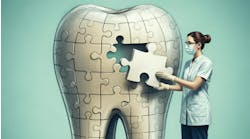For more on this topic, go to www.dentaleconomics.com and search using the following key words: Dr. Bill Strupp, tooth preparation, tissue management, impressions, Dr. Jeff Dalin.
Dr. Dalin: I have attended many of Dr. Bill Strupp's lectures. Let's begin with tooth preparations. Bill, what do you teach about porcelain veneers and minimal, moderate, and maximal preparations?
Dr. Strupp: Thanks, Jeff, for the opportunity to speak with you. I have always enjoyed reading Dental Economics®, and am pleased to offer my perspective.
I like porcelain veneers because they allow me to be conservative with reduction of tooth structure; however — on certain occasions — tooth preparation must be more aggressive when using veneers. Reduction for porcelain veneers is driven primarily by four factors: 1) the substrate color (color of the prepared tooth structure), 2) the extent of pathology present (decay, demineralized dentin, fractures, fillings), 3) occlusal function or parafunction, and 4) the esthetic desire of the patient.
When the substrate color is white, minimal reduction of tooth structure (0.2 to 0.5 mm reduction facially) can be done to provide the room necessary for beautiful, strong, and biologically conservative veneers that can satisfy the cosmetic needs of most patients. This reduction volume is ideal from the perspective of the preservation of biology and producing the best cosmetic result. In addition, it preserves enamel — the best substrate to bond with resin composite.
If the substrate color is darker, the reduction requirement for veneers falls into the moderate category. Facially, that is 1.0 mm, which exposes a certain amount of dentin. If there is moderate pathology, moderate reduction is also frequently required. In those instances when the substrate color is darker after the enamel is removed and dentin is exposed, further reduction may be required.
When the substrate color is very dark or extensive pathology exists, reduction of at least 1.5 mm is needed to provide a good cosmetic outcome. Such maximal reductions are commonplace for porcelain–to–metal, porcelain–to–zirconia, porcelain–to–lithium disilicate, and certain pressed feldspathic porcelains. Enamel is completely removed with this amount of reduction. In many cases, such severe reduction creates a biomechanical compromise that can actually perpetuate pathology instead of reducing or eliminating it. I rarely choose systems that require this volume of reduction.
To manage occlusal forces of most veneer preparations, incisal edge reduction of 2.0 mm is necessary. In addition, interproximal reduction facilitates better cosmetic contouring, easier laboratory procedures, and cleanability of the veneers by the patient without sacrificing the tooth's rigidity.
The goal with most veneer preparations is to reduce only as much as is absolutely necessary to achieve a patient's requisite cosmetic, phonetic, functional, and health results. Preservation of biology is the real beauty of porcelain veneers.
Dr. Dalin: Does this philosophy adapt when preparing teeth for onlays or full coverage?
Dr. Strupp: Yes. In posterior all–ceramic dentistry for onlays and full coverage, a minimum of 2.0 mm of occlusal reduction is necessary. When using feldspathic porcelain without a foundational core, which is what I do in most cases (I call this refractory porcelain), the thickness can be unlimited. Usually, 3.0 mm is the most reduction that I do.
Dr. Bill Strupp
When a bilaminar system is used, the thickness of veneering porcelain is limited to 2.0 mm. Bond strength of veneering porcelain–to–zirconia cores is 50% or less than that of porcelain–to–metal. Bilaminar materials also require abusive facial and lingual reduction. When using refractory porcelain for onlays and full coverage, facial reduction of 0.2 to 0.5 mm is adequate. Usually, no lingual reduction is required for most partial coverage, all–ceramic posterior restorations. In addition, supragingival margination is almost always used — either with onlays or full coverage.
Dr. Dalin: What about tissue management and impressions?
Dr. Strupp: Tissue is the issue. If the tissue is not healthy after treatment, a patient's long–term health could be seriously compromised. The scientific correlation between dental infections and systemic disease is real. We can no longer ignore this fact, regardless of what we have done in the past.
Supragingival margination circumvents tissue management issues that can compromise the quality of the final crown and bridge case from the perspective of iatrogenic infection and cosmetics. Subgingival margination is the equivalent of sticking a bamboo shoot under the fingernail bed. Try as you may, the tissue under that fingernail bed will always be inflamed and irritated. The same is true for the biologic width around a tooth that has subgingival margins.
To address your question concerning impressions, impression materials tear off in the sulcus because they fail to set completely. The inhibiting factor of the complete set is the presence of contaminants such as gloves, bonding resins, grinding debris, or plaque. But if the tissue is scrubbed with a toothbrush using 4% chlorhexidine gluconate, most of the contaminants that compromise impression materials from completely setting can be eliminated.
The sulcus should also be scrubbed with 4% CHG, using an Inspiral brush from Ultradent on a 3–cc syringe. In addition, using small retraction cords without pressure packing and avoiding the use of harsh chemicals will go a long way toward keeping tissue healthy.
Dr. Dalin: What is your opinion of digital impression systems such as 3M ESPE's Lava COS and Cadent's Itero, and the CAD/CAM systems from CEREC and D4D?
Dr. Strupp: I think the future of impressions is with these systems. I look forward to the day when the ease and predictability of use of these systems eliminates the need for making impressions with conventional materials.
Dr. Dalin: Do you have any ways to help people with shade selection? I know that digital photography can be a great help.
Dr. Strupp: Digital photography is certainly a must for communication with shade–taking, but setting color profiles for computer monitors that match the actual color of the photograph is equally important. The most important aspect of shade–taking is to understand the light–handling properties of the materials used for making the restorations. I wrote about this in detail in Crown & Bridge UPDATE and online in Crown & Bridge UPDATE Interactive.
Final restoration color depends on how light is handled by three distinct elements: the substrate, porcelain, and cement. Selecting the porcelain, color and opacity is based on which area of the tooth the porcelain is to be used. Gingivally, I choose porcelain that is relatively translucent and has the exact color of the substrate. Incisally and facially, I choose a bleached enamel color for the porcelain because I bleach every case before I restore it, using Life–Like's 30% carbamide peroxide bleaching products.
If dentin is removed by the preparation design, it is replaced with dentin porcelain of the appropriate color for the new restoration. In essence, porcelain color is chosen in color and opacity for the tooth structure that has been reduced, except at the gingival aspect where translucent substrate color porcelain will allow the dentist to use invisible supragingival margins in critical cosmetic zones.
Dr. Dalin: What about bonding agent systems? Many prefer self–etching primer for their simplicity and reduced postop sensitivity. Others won't use anything past fourth or fifth generation systems.
Dr. Strupp: Bonding agent selection is a matter of preference. I prefer Protect Bond from Kuraray when placing light–activated resin composite. I prefer All Bond 3 from Bisco when placing chemical–activated resin composite. The key for any of these agents is a dry field and no contamination. All systems work if used properly, but systems fail when moisture contamination is present. I believe the use of a dedicated air syringe with no water attached to it is mandatory for success.
Dr. Dalin: Thank you, Bill. Is there anything else you would like to discuss?
Dr. Strupp: Thank you for the invitation. My focus is on helping general dentists to diagnose comprehensively and treatment plan complex cosmetic and restorative dentistry in order to simplify the management and increase the predictability of their treatment.
The seminars I teach are aimed at doing that, as well as increasing the confidence the dentist has with such cases. There are many complex treatment protocols taught that are simply unnecessary and overly complicated. I believe that predictability increases with simplified protocols that anyone can use, without having to buy thousands of dollars' worth of complex proprietary equipment or going through endless meaningless tasks and seminars.
Our dental focus should be on patient health, function, phonetics, and cosmetics — not on adhering to exotic treatment protocols that waste our time and patients' money. The key is to know how to never do anything more than is necessary to perfectly restore a case while also never doing anything less.
Dr. Bill Strupp is a clinician and speaker who is an Accredited Fellow and Founding Speaker of the AACD. He will offer a seminar, “Simplifying Complex Cosmetic and Restorative Dentistry,” Jan. 29–30, 2010, in Clearwater Beach, Fla., and June 25–26, 2010, in Santa Barbara, Calif. Contact him at [email protected].
Jeffrey B. Dalin, DDS, FACD, FAGD, FICD, practices general dentistry in St. Louis. Contact Dr. Dalin at [email protected].







